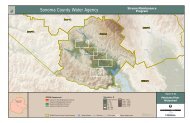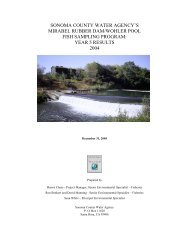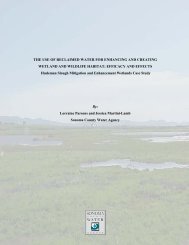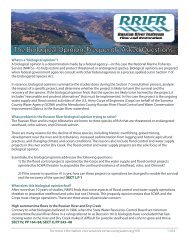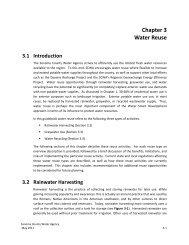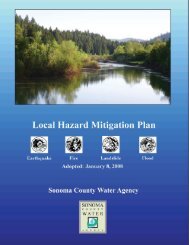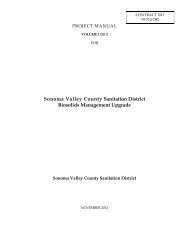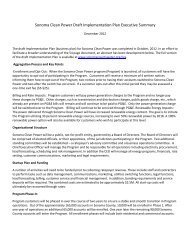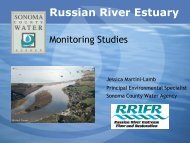Hydrography of the Russian River Estuary - Sonoma County Water ...
Hydrography of the Russian River Estuary - Sonoma County Water ...
Hydrography of the Russian River Estuary - Sonoma County Water ...
You also want an ePaper? Increase the reach of your titles
YUMPU automatically turns print PDFs into web optimized ePapers that Google loves.
easily over denser estuarine waters in <strong>the</strong> absence <strong>of</strong> tidal and wind mixing. Later in <strong>the</strong><br />
afternoon, during <strong>the</strong> weak flood tide, an inflow <strong>of</strong> 5-20cm/s was observed extending<br />
several feet down from <strong>the</strong> surface. While supported by <strong>the</strong> tide, this surface-amplified<br />
inflow is primarily due to an afternoon/evening sea-breeze that is felt on <strong>the</strong> estuary<br />
between Paddyʼs Rock and <strong>the</strong> mouth.<br />
Figure 3.10. <strong>Water</strong> levels (top panel) and pr<strong>of</strong>iles <strong>of</strong> along-channel speed (bottom<br />
panels) at Paddy's Rock on 11-12 July 2009, during a tidal cycle with a range <strong>of</strong> ~3 ft<br />
and Guerneville river flow <strong>of</strong> 110 cfs. Negative velocities indicate flow toward <strong>the</strong> mouth.<br />
Along-channel currents on 11-12 July 2009 (Figure 3.10) are stronger and observed<br />
throughout <strong>the</strong> 22ft-deep water column, with an intriguing vertical structure. At low tide<br />
on <strong>the</strong> morning <strong>of</strong> 11 July, a 5ft layer <strong>of</strong> low-salinity water is observed to be flowing<br />
seaward. This reverses to an inflow over <strong>the</strong> uppermost 10ft during <strong>the</strong> subsequent<br />
flood tide. However, by <strong>the</strong> time <strong>of</strong> <strong>the</strong> afternoon ebb tide, <strong>the</strong> afternoon sea-breeze has<br />
started and <strong>the</strong> 17h00 pr<strong>of</strong>ile shows <strong>the</strong> uppermost 2ft moving landward due to surface<br />
wind stress while <strong>the</strong> waters between 2ft and about 12ft depth are seen to move<br />
seaward due to barotropic tidal pressure gradients. Below this, <strong>the</strong> near-bottom waters<br />
are moving landward (establishing a 3-layer flow structure, with mid-depth waters<br />
flowing seaward between surface and bottom waters). This sub-pycnocline inflow is also<br />
evident in <strong>the</strong> 15h00 pr<strong>of</strong>ile and most dramatically seen in <strong>the</strong> pr<strong>of</strong>ile at spring high tide<br />
25





